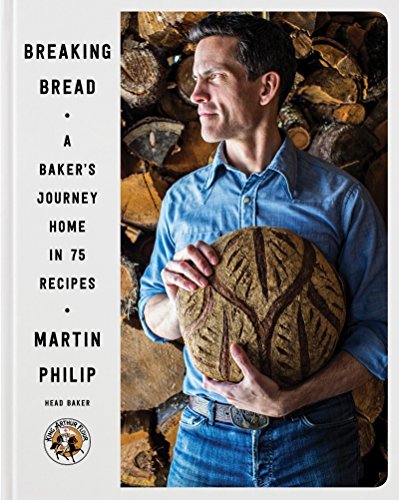What do you think?
Rate this book


391 pages, Kindle Edition
Published October 31, 2017
At King Arthur Flour the bakery building is divided into separate clusters for bread and pastry work. [...] For bread the main tools include a steam-injected masonry oven [...] There are also mixers designed for artisan dough and wooden benches where hand shaping is done. And hands, experienced hands, the most flexible, versatile, and valuable tools in the world. [Vermont]
[M]any roads will lead to the land of "naturally leavened," also known as "sourdough" or "levain" bread making. Even among professional bakers, these terms, which essentially refer to bread made with a leavening culture, can be a source of confusion. [...] The terms naturally leavened (meaning no commercial yeast) and levain are also used to refer to sourdough culture. Naturally leavened is misleading as bread made with commercially produced yeast isn't necessarily unnatural. Levain is the French word for "leaven." The point of all this is that bread made with a leavening culture is more flavorful. [...] You do not need to wave the open container about, hoping to "catch" anything; you do not need to add exotic juice or grapes or sugar or yeast or get any fancier than the product of these two ingredients plus time. [Method | Sourdough Culture]
It's OK to laugh at young parents; we are asking for it. As I think of the things we did for our first and juxtapose it with the treatment our third has received . . . it's appropriate to chuckle. With the first we set records for attentiveness, catering to every micro-need. Is that organic, is it natural, is it BPA-free? And what soap did you use to wash those bananas (before peeling them)? And on and on. But then, things slip with the second child. An exception here, an allowance for junk food there . . . and, if a third child arrives well, we're over the cliff now. "I'm hungry"can be fixed at a gas station. But before things relaxed we made quite a few delicious muffins for our baby girl—something to feed her amid spoon-fed meals of organic baby food. [Introduction to chocolate orange muffins and banana pecan muffins]
The details of this story are mine but they are not unique. We all have tales, lives with beginnings, heartache, happiness, movement, and endings. I hope that you find yourself inspired to bake your own narrative, to connect the lines of your experience to your own environment, your family, and those around you, for baking and giving are truly acts of love. [author's note]
~ ~ ~ ~ ~
At our house, bread making was a ritual, reliable and grounding in its weekend occurrence, something to be repeated, revisited, and awaited. [...] What does bread baking smell like in heaven? It smells like bread baking.
[...]
[W]hile this bread sustained us at home, it was shameful in the school lunch box. Sitting at the lunchroom table, surrounded by classmates and their blue or red milk choices, I would have given a kidney for that 1970s staple: crustless Wonder bread with Skippy and Smucker's grape jelly glue. I would have gladly sported an orange mouth ring of Cheetos crumbs and devoured a frosted Hostess cake in order that their chemicals could swirl kaleidoscopic in my gut. [...] [W]hile I may have decried that bread, even hidden it, years later I have turned things around. I've headed back to this form, which is entirely more delicious and healthy than plump factory loaves pumped with chemicals ranging from azodicarbonamide (also used in floor mats) to potassium bromate (known carcinogen). Supermarket aisles are proof that if you add enough high-fructose corn syrup, preservatives, and stabilizers, people will still eat the packaged stuff months after it is produced. [Part 1 | Recipes and Stories: Mama's Bread]
~ ~ ~ ~ ~
Before Food Network, before "EVOO" and "Bam!" entered the stockpot of our lexicon, and well before the cult of celebrity replaced the cult of capability, there was a series on PBS called Great Chefs. [...] [T]he shows were the best thing before food TV and have remained the greatest thing since. Episodes were built around cities and their great foods, focusing tightly on technique, flavor, and craftspeople. They were a gateway drug that led me to Baking with Julia, Jacques Pépin, and beyond. It is no exaggeration to say that I received my informal culinary education in thirty-minute chunks. [Part 1 | Leaving: Basic French dough]
~ ~ ~ ~ ~
The hill towns of Italy, rising from verdant plains, are built on rocks holding stacked fortress walls constructed of stones from underfoot a millennium earlier. These layers of earth, stone, and home are honest and resonate as fully and naturally as tones of a chord align and ring. The imagined world of Italy, which we'd lived between the flat covers of Puccini opera scores, was vibrant and breathing before our eyes in a way we could eat. The simplicity, and the sense of it all, changed me; there was no going back; there was only going closer. [Part 1 | Leaving: Pane Genzano]
~ ~ ~ ~ ~
Defining "home" is best done in retrospect—standing within four walls of our current existence doesn't allow the space or frame of time and place to provide the long view. As I watch my children grow I wonder what, of all this, will they long for or remember? What will be their "home" of memory? Will it be smells, a baking tradition, the music of voices and instruments, an overserious father? Memories are laid like bedrock, deep, under our very feet, invisible in the forming but ever active. There are things that I hope will remain as family memories—small weekly rituals, meals, seasonal recurrences, and holiday events. I may be wrong, but some of these might be keepers, and if strung together may fill their scrapbooks of home. [Home]